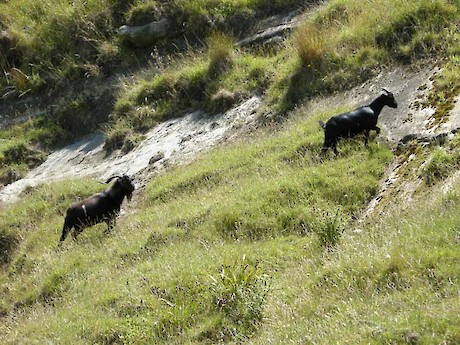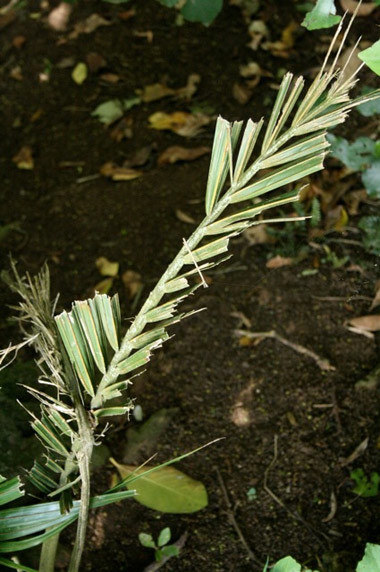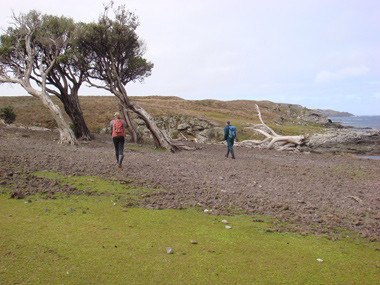 Wild goats at Cook’s Cove, East Coast. Photographer: John Sawyer.Ungulate is the collective term for a broad range of animals, usually herbivorous, which walk on the tips of their (generally hoofed) toes. Some ungulates, especially cattle (Bos taurus) and sheep (Ovis aries), are traditional cornerstones of the New Zealand economy. Others (particularly deer and pigs) are of cultural importance as game animals. All species are capable of causing significant damage to plant communities. There are at least fourteen extant species of feral ungulate in New Zealand, including cattle, sheep, goats, tahr, chamois, horses, pigs, and the seven species of deer (fallow, red, wapiti, sika, rusa, sambar, whitetail). A number of other ungulates including moose, axis deer and even zebra were historically liberated in New Zealand but are considered to have since died out; others, including llamas and alpacas, are present in New Zealand but have not established in the wild.
Wild goats at Cook’s Cove, East Coast. Photographer: John Sawyer.Ungulate is the collective term for a broad range of animals, usually herbivorous, which walk on the tips of their (generally hoofed) toes. Some ungulates, especially cattle (Bos taurus) and sheep (Ovis aries), are traditional cornerstones of the New Zealand economy. Others (particularly deer and pigs) are of cultural importance as game animals. All species are capable of causing significant damage to plant communities. There are at least fourteen extant species of feral ungulate in New Zealand, including cattle, sheep, goats, tahr, chamois, horses, pigs, and the seven species of deer (fallow, red, wapiti, sika, rusa, sambar, whitetail). A number of other ungulates including moose, axis deer and even zebra were historically liberated in New Zealand but are considered to have since died out; others, including llamas and alpacas, are present in New Zealand but have not established in the wild.
 Nikau frond browsed by cattle. Photographer: Jack Mace.The first ungulates released in New Zealand were pigs and goats, introduced to Hawke’s Bay and the Marlborough Sounds by Cook in 1773. Further animals were subsequently introduced to provide meat and fibre for castaways, as gifts and trade goods for Māori, and through farm escapes. A number of species, particularly deer, tahr and chamois, were released in the interests of fostering game hunting in New Zealand.
Nikau frond browsed by cattle. Photographer: Jack Mace.The first ungulates released in New Zealand were pigs and goats, introduced to Hawke’s Bay and the Marlborough Sounds by Cook in 1773. Further animals were subsequently introduced to provide meat and fibre for castaways, as gifts and trade goods for Māori, and through farm escapes. A number of species, particularly deer, tahr and chamois, were released in the interests of fostering game hunting in New Zealand.
The impact of feral ungulates varies by species. Deer, goats, pigs, cattle and sheep are implicated in the prevention of canopy regeneration through consumption of palatable seedlings and fallen fruit; combined with the depredations of possums, this can lead to forest collapse, as documented in the southern Ruahine ranges in the 1950s. All ungulate species are capable of causing significant changes to the floristic structure of ecosystems through selective browse of palatable species, and ungulates have been responsible for the near-extinction of a number of plant species (e.g. kakabeak, waiu-atua) on the mainland. Feral pigs have also been implicated in predation of native species, most notably Powelliphanta snails and kiwi.
 Feral pig damage to coastal turf communities on Chatham Island / Rekohu. Photographer: Peter de Lange.Although the distribution of some species is now extremely limited (e.g. horses to the central North Island and the Aupori Peninsula), ungulates of one species or another are found throughout New Zealand’s main islands and many offshore islands. The range of some deer species may be growing through a mixture of natural expansion and illegal releases. The Department of Conservation has successfully eradicated ungulates from several offshore islands, including Raoul and Campbell, and has a number of ongoing control programmes aimed at eradicating or controlling existing populations and preventing the establishment of species outside their current feral ranges.
Feral pig damage to coastal turf communities on Chatham Island / Rekohu. Photographer: Peter de Lange.Although the distribution of some species is now extremely limited (e.g. horses to the central North Island and the Aupori Peninsula), ungulates of one species or another are found throughout New Zealand’s main islands and many offshore islands. The range of some deer species may be growing through a mixture of natural expansion and illegal releases. The Department of Conservation has successfully eradicated ungulates from several offshore islands, including Raoul and Campbell, and has a number of ongoing control programmes aimed at eradicating or controlling existing populations and preventing the establishment of species outside their current feral ranges.
For more information see*:
*The Network is not responsible for the content of external internet sites
